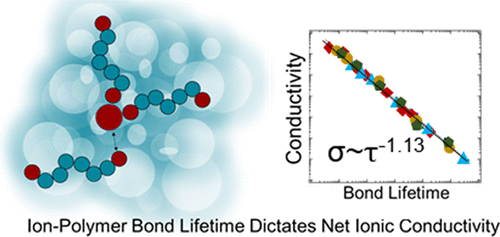当前位置:
X-MOL 学术
›
Macromolecules
›
论文详情
Our official English website, www.x-mol.net, welcomes your
feedback! (Note: you will need to create a separate account there.)
The Role of Polymer–Ion Interaction Strength on the Viscoelasticity and Conductivity of Solvent-Free Polymer Electrolytes
Macromolecules ( IF 5.1 ) Pub Date : 2020-11-25 , DOI: 10.1021/acs.macromol.0c02233 Seamus D. Jones 1, 2 , Nicole S. Schauser 2, 3 , Glenn H. Fredrickson 1, 2, 3 , Rachel A. Segalman 1, 3
Macromolecules ( IF 5.1 ) Pub Date : 2020-11-25 , DOI: 10.1021/acs.macromol.0c02233 Seamus D. Jones 1, 2 , Nicole S. Schauser 2, 3 , Glenn H. Fredrickson 1, 2, 3 , Rachel A. Segalman 1, 3
Affiliation

|
Metal–ligand coordinating polymers utilize labile bonds between polymer-bound ligands and free cations to delocalize and conduct mono and multivalent metal ions in the solid state. These interactions simultaneously act as reversible cross-links, leading to delayed terminal relaxation as measured by oscillatory rheology. Well-controlled poly(methyl acrylate)s with imidazole chain ends are synthesized as model polymers to obtain metal–ligand bond lifetimes and to investigate design rules for solid polymer electrolytes. Through changes in identity of the metal species, metal–ligand bond lifetimes are varied over nearly two orders of magnitude. Scaling analysis demonstrates a correlation between the bond lifetime and the ionic conductivity, suggesting a hierarchical conduction mechanism that involves interplay of polymer segmental motion with the dissociation of metal–ligand bonds. This suggests an alternative means to enhance long-range ionic transport that is partially decoupled from efforts to enhance the segmental mobility of ion-conducting polymers.
中文翻译:

聚合物-离子相互作用强度对无溶剂聚合物电解质的粘弹性和电导率的作用
金属-配体配位聚合物利用聚合物结合的配体和游离阳离子之间的不稳定键来使固态的单价和多价金属离子离域并传导。这些相互作用同时充当可逆交联键,导致延迟的弛豫,如通过振荡流变学测量的。合成具有良好控制能力的具有咪唑链端的聚丙烯酸甲酯作为模型聚合物,以获得金属-配体键的寿命并研究固体聚合物电解质的设计规则。通过改变金属种类的身份,金属-配体键的寿命在近两个数量级上变化。结垢分析表明键寿命与离子电导率之间存在相关性,提出了一种层次传导机制,涉及聚合物节段运动与金属-配体键解离的相互作用。这表明增强远程离子迁移的另一种方法与增强离子导电聚合物的分段迁移率的努力部分脱钩。
更新日期:2020-12-08
中文翻译:

聚合物-离子相互作用强度对无溶剂聚合物电解质的粘弹性和电导率的作用
金属-配体配位聚合物利用聚合物结合的配体和游离阳离子之间的不稳定键来使固态的单价和多价金属离子离域并传导。这些相互作用同时充当可逆交联键,导致延迟的弛豫,如通过振荡流变学测量的。合成具有良好控制能力的具有咪唑链端的聚丙烯酸甲酯作为模型聚合物,以获得金属-配体键的寿命并研究固体聚合物电解质的设计规则。通过改变金属种类的身份,金属-配体键的寿命在近两个数量级上变化。结垢分析表明键寿命与离子电导率之间存在相关性,提出了一种层次传导机制,涉及聚合物节段运动与金属-配体键解离的相互作用。这表明增强远程离子迁移的另一种方法与增强离子导电聚合物的分段迁移率的努力部分脱钩。











































 京公网安备 11010802027423号
京公网安备 11010802027423号